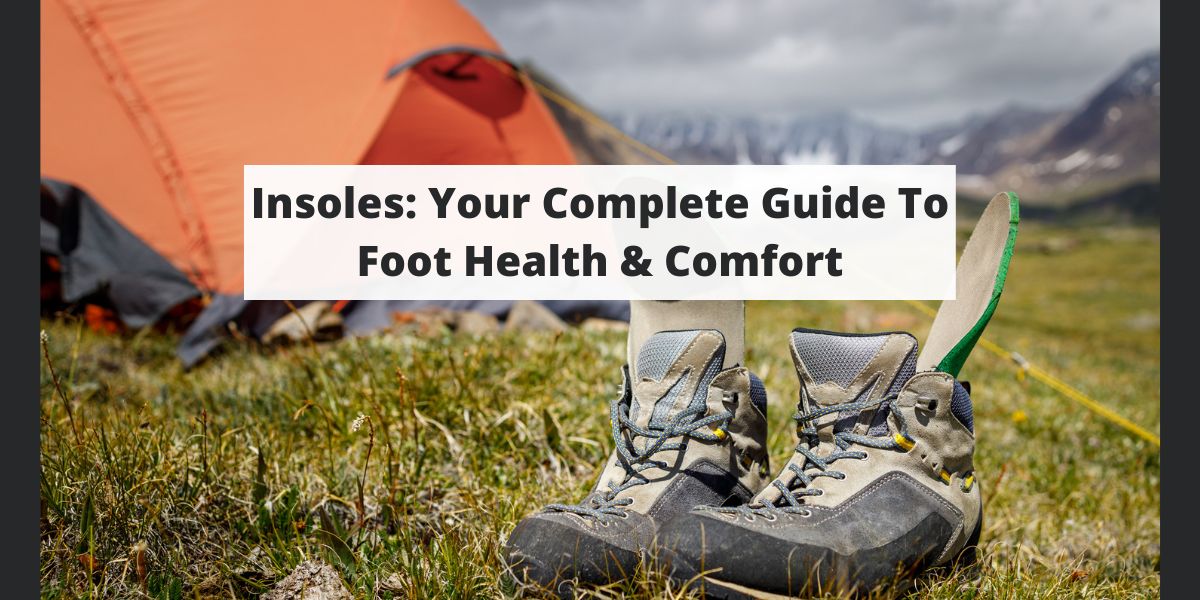



If you’ve ever taken a look at the insoles that came with your hiking boots or your basic sneakers, you’ll probably notice that they are cheap and flimsy, and don’t really do anything. This isn’t necessarily an issue unless you experience foot or leg discomfort. Proper insoles can help keep your feet safe and healthy. They can help with proper foot position, prevent blisters and hot spots, and keep your feet more comfortable as you hike. There are lots of different types of insoles that can help with different issues, so read on to discover the different kinds of insoles and what they can do!
An insole is a removable insert that is placed inside a shoe to provide additional support to the foot. Insoles are designed to enhance the fit and function of footwear, improving overall foot health and reducing discomfort.
Insoles can be made from a variety of materials, including foam, gel, rubber, cork, memory foam, wool, and leather. They are typically contoured to match the shape of the average foot and may have specific features to address various foot conditions or provide targeted support.
Insoles provide support and cushioning to the foot’s arch, heel, and forefoot areas. They help distribute pressure more evenly across the foot, reducing the strain on specific areas and promoting proper alignment. Insoles can also help absorb shock, provide stability, and improve overall biomechanics during walking, running, or other activities.
The term “insole” and “orthotic” are often used interchangeably. But insoles and orthotics are not exactly the same thing. An orthotic can be thought of as a custom insole. They both provide cushioning and support, but orthotics are made to fit your feet. Insoles are more generalized. They still protect your feet and provide extra support and cushioning in your shoes– but if you have severe foot problems or want a more custom fit, you may want to speak to a podiatrist, get an online recommendation, or use an orthotics kiosk (found in many drugstores and shoe stores).
Our feet have two arches: a transverse arch, which runs side to side, and a longitudinal arch, which runs front to back. These arches are stiff and act like springs as we walk and run, making our locomotion highly efficient. We need these stiff arches; without them, walking would take much more energy and we wouldn’t be able to move the long distances that we do. But because we have these complex biomechanics, our feet need more support than they often get.
Well-designed insoles are made to engage with both arches of the foot. Insoles are typically contoured to mimic the shape of the longitudinal arch. They help maintain the arch’s proper height, preventing it from collapsing excessively (overpronation) or becoming overly rigid (underpronation). By supporting the arch, insoles distribute weight more evenly across the foot and reduce stress on the plantar fascia, preventing conditions like plantar fasciitis.
Insoles also support the transverse arch by featuring metatarsal pads or cushions that lift and support the transverse arch. This relieves pressure on the forefoot and promotes a more balanced weight distribution, which can help reduce pain and prevent injury from overcompensatory movement.
There are several different types of insole, each type designed with a specific purpose in mind:
Typically, you want to use sport insoles for hiking.
The answer to this question is that it depends. If you are someone that traditionally doesn’t use insoles, and never has issues with foot pain, shin splints, leg pain, or other ailments that could potentially be helped by insoles, you probably shouldn’t change anything. With footwear, it is often change that can cause issues. That being said, if you are experiencing pain or issues, insoles can be a potential solution. You should conduct some research, and consult a podiatrist for the best possible recommendations based off of your needs.
Many people swear by zero drop, barefoot, minimalist, or other designs of footwear that more closely mimic being barefoot. We have no doubt that thousands of people have received benefits from these types of shoes. That being said, going in that direction may not be right for you. With footwear, it is crucial to understand that what works for others may not work for you, and if you make large changes to your footwear, like changing to zero drop shoes, or making large insole changes, you may actually experience more pain and discomfort. This could be short term, or it could be long term.
We simply want to remind readers that foot health is dependent upon a lot of factors, and major changes can cause issues.
Insoles can help with a number of conditions, as well as offer overall support and superior comfort. Here are the key benefits to wearing insoles.
Insoles can help correct foot alignment issues such as overpronation (excessive inward rolling of the foot) or supination (insufficient inward rolling), which can lead to discomfort and injuries. They provide support to the arches, redistributing pressure and promoting proper foot and leg alignment.
Insoles come in three types of arch support: support for high arches, support for typical arches, and support for dropped arches or flat feet. Make sure that you choose the correct kind of arch support; wearing the wrong type of arch support can hurt.
An important consideration for the winter hiker, runner, or snow sports enthusiast, some insoles can help keep your feet warm inside of your boots. Wool insoles are great for this, since wool retains its insulating properties even if it gets wet.
Hiking, running, or walking can subject your feet to repeated impact and pressure. Insoles with cushioning properties help absorb shock, reducing stress on the feet, ankles, and knees. They provide a layer of padding that can alleviate discomfort and fatigue during long hikes.
Insoles can also help reduce blisters. Blisters are caused by friction from your shoe rubbing against your foot, and your shoe can only rub if there’s space for it to move that way. Insoles take up extra space in the interior of your shoe and can help prevent blisters from forming by stopping the footwear from rubbing. Insoles can also help relieve pressure points and stop hot spots from forming.
High-quality insoles can enhance stability and balance, especially on uneven terrain. They help reduce foot fatigue and the risk of slips, falls, and ankle injuries by providing additional support and stability to the foot’s natural structure. Insoles with deep heel cups are great for extra ankle support, so consider this if you’re prone to rolled ankles.
Some insoles feature moisture-wicking properties, helping to keep your feet dry and comfortable during hikes. They can also have antimicrobial treatments to prevent the growth of odor-causing bacteria, keeping your feet fresh and odor-free.
Insoles are often worn for specific pain and body issues. These include, but are not limited to:
Insoles can also help with back pain and other problems caused by your stance or gait. If these problems are severe, you should speak with a medical professional for help with a custom-fit orthotic. You don’t want to aggravate these problems any further.
First, identify your specific concern. What do you want your insoles to do? Do you want to reduce fatigue? Do you have a stance or gait issue that needs to be addressed? Look for insoles designed to help with these problems. For hiking, you want to make sure that the insole you choose helps with foot rotation and support, as well as foot fatigue.
Another thing you need to consider is how your boots fit, and how thick your socks are. Insoles come in different volumes, and your socks can have a major impact on how much space there is for the insole to fill. If you wear thick socks every time you hike, that reduces the overall volume to fill in your shoes.
Insole volume varies, and can correlate with arch support. High-volume insoles work best with high arches and fit high-volume shoes, such as hiking boots and running shoes. Be careful with these though– if you have flat feet, a high-volume insole can cause pain.
Medium-volume insoles work best with casual shoes and athletic footwear that doesn’t have as much space inside. Low-volume insoles work best if you have flat arches, or have tight-fitting shoes like cycling shoes. If you’re not sure, medium-volume insoles work with the widest variety of arch profiles.
Once you’ve chosen an insole to try, you need to try it on both outside and inside of your shoe. First, stand on the insole outside of the shoe. Lift one foot to balance on the insole, and note how stable you feel. Is your heel supported? How much pressure is there?
Then, try the insole inside your shoe. How is the fit, the feel, and the support? You need to feel stable in the shoe. Make sure that you remove the stock insole first- that thin piece of fabric on the bottom of your shoe.
Insoles are typically sold in size ranges. In many cases, you will need to trim your insoles at the toe to adjust them to the precise size and fit of your shoe. This is definitely a case where you want to measure multiple times before cutting, because you can’t add the material back.
When you take insoles out on the trail, you need to choose a pair that’s heavy-duty and made of foam or another stiff material. Gel inserts might be comfy if you’re standing on your feet at work, but they are not good for hiking. They don’t have a great grip and can slide around in your boots, creating more problems than they solve.
A more rigid foam insole, however, provides support and moves with your foot. Foam insoles can also provide extra support for the challenges of hiking. Insoles like the Superfeet Trailblazer (See on REI) insoles or the Currex HikePRO insoles aren’t designed to change the shape of your foot profile– instead, they’re designed to fill the gap in your shoes. The more surface area of your foot in contact with the shoe, the less pressure and fatigue you will feel from unnecessary movement.
Everybody knows that feet can get stinky, which means that your boots– and your insoles– can get gross, too. You need to properly care for your insoles to keep them from getting smelly and to ensure that they last a long time.
When you take off your boots on a hike, remove the insoles and let them air out. This will let the moisture that gets trapped between the shoe and the insole evaporate. You should also wash your insoles from time to time. Do this by hand and use a mild detergent or a soap designed to be used with sports equipment. Antimicrobial sprays aren’t a bad idea. Let them dry entirely before reinserting.
Insoles don’t last forever. Depending on how frequently you use them, they will wear out over time. For daily wear, high quality insoles will usually last around a year– sometimes much longer, depending on the material and how much you’re on your feet. For hiking, you can expect a good pair of insoles to last around 500 miles.
You should inspect your insoles periodically. Look for cracks, tears, and other signs of wear and deterioration. Hiking on damaged insoles can lead to a reduced level of support than what you were expecting, which can lead to injury.
Overall, a pair of good insoles can help protect your feet and ankles from pain and injury. You just need to make sure that you have the right ones for your needs! Don’t be afraid to try on different insoles until you find the ones that have the perfect fit.

